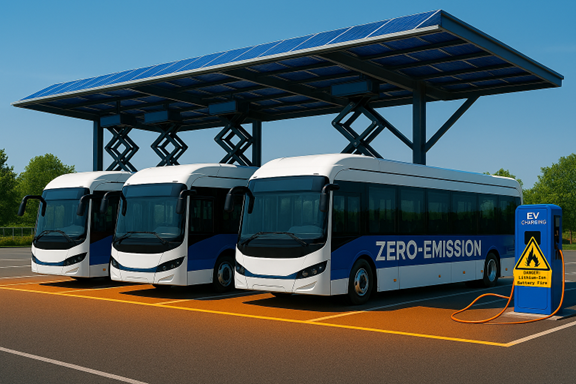Context
Australia’s public transport is going electric, and the change is happening fast. Across our cities, bus depots are being transformed to support fleets of zero-emission electric buses. It is a revolution that promises cleaner air, quieter streets, and a big step toward meeting our climate goals. But as with any leap forward, new challenges arise, especially when it comes to keeping these depots safe from fire.
Why Electric Bus Depots Are Different
Traditional bus depots were designed for diesel vehicles. Fire risks including fuel leaks, engine fires, and occasional electrical faults were well understood. But electric buses bring a new hazard to the table, the lithium-ion battery. These batteries are powerful, compact, and essential for long-range, reliable service. Yet, they also introduce risks that are fundamentally different from anything diesel ever posed.
The most significant concern is “thermal runaway.” This is a chain reaction inside a battery pack that can be triggered by a manufacturing defect, physical damage, or even overheating during charging. When it happens, temperatures can soar above 600°C in seconds, releasing toxic and flammable gases like carbon monoxide and hydrogen fluoride. Fires can start inside the battery, making them hard to detect and even harder to put out. Unlike diesel fires, lithium-ion battery fires can reignite hours or days after they seem extinguished.
A New Approach to Fire Safety
So, how do we keep our electric bus depots safe? The answer is not just more fire extinguishers or bigger hoses. It requires a holistic, performance-based approach that looks at every aspect of depot design, operation, and emergency response.
Smart Layouts and Separation
First, depot layouts are being reimagined. Buses need to be parked with enough space between them to prevent a fire from jumping from one vehicle to another. Charging stations are placed with care, and critical infrastructure such as control rooms and battery storage areas, are given extra protection. Emergency access routes must be mapped out so firefighters can get in quickly, even if a fire breaks out in the middle of the night.
Early Detection and Suppression
Next comes detection. Modern depots use a mix of thermal cameras, gas sensors, and smart alarms to spot trouble before it starts. If a battery begins to overheat or leak gases, the system can alert staff and even shut down charging automatically. Suppression systems are also evolving. Water-based sprinklers, designed to meet Australian Standards AS 2118.1 and AS 2118.6, are now the gold standard for lithium-ion battery fires. These systems can deliver high volumes of water to cool batteries and prevent the spread of toxic smoke.
Battery Management and Charging Protocols
Behind the scenes, Battery Management Systems (BMS) monitor each bus’s battery in real time. These systems track temperature, charge levels, and even tiny changes in voltage that could signal a problem. Smart charging protocols help prevent overcharging which is a major cause of thermal runaway. Some depots are switching to lithium iron phosphate (LFP) batteries, which are less prone to fire than older chemistries.
Emergency Response and Environmental Protection
Fire safety does not stop at the depot gates. Local fire services are now working closely with depot operators to develop tailored emergency response plans. These plans include training for EV-specific incidents, protocols for isolating damaged vehicles, and strategies for dealing with hazardous runoff if water used to fight a fire becomes contaminated. Environmental protection is a growing concern, with new guidelines for containing and treating fire water to prevent harm to local waterways.
Regulatory and International Best Practice
Australia’s National Construction Code (NCC) now includes special clauses for EV infrastructure, requiring enhanced fire safety measures and performance-based design. The Australasian Fire and Emergency Service Authorities Council (AFAC) recommends open-air charging locations, automatic sprinklers, and robust hydrant coverage. Internationally, standards like NFPA 855 (USA), UL 9540A, and the International Fire Code (IFC) Section 320 set benchmarks for lithium-ion battery safety. Europe’s CFPA Guideline No. 44:2025 F offers best practice advice for EVs and charging stations.
Learning from Real-World Experience
Recent case studies from Australia and overseas show that outdoor depot layouts with natural ventilation, physical barriers between buses and chargers, and advanced suppression systems are making a real difference. Emerging technologies such as solid-state batteries, early detection sensors, and AI-driven predictive maintenance promise even greater safety in the future.
A Team Effort for a Safer Tomorrow
Keeping electric bus depots safe is not just about technology, it is about teamwork. Fire engineers, depot managers, bus operators, and emergency services are working together to develop solutions that are robust, scalable, and ready for the future. Risk management frameworks like ISO 31000 and NSW’s HIPAP 2 Fire Safety Study Guidelines help guide these efforts, ensuring that every risk is identified and addressed.
Looking Ahead
As Australia’s bus depots evolve to support sustainable transport, fire safety must keep pace. The move to electric buses is a chance to rethink how we protect people, property, and the environment. By combining smart design, cutting-edge technology, and strong partnerships, we can ensure that our journey to a greener future is also a safer one.
References
- National Construction Code (NCC) Clauses E1D17, E2D21
- AS 2118.1, AS 2118.6 (Automatic Fire Sprinkler Systems)
- Australasian Fire and Emergency Service Authorities Council (AFAC) Position Statement on EVs
- Australian Building Codes Board (ABCB) EV Guidance
- NFPA 855: Standard for the Installation of Stationary Energy Storage Systems
- UL 9540A: Test Method for Evaluating Thermal Runaway Fire Propagation in Battery Energy Storage Systems
- International Fire Code (IFC) Section 320
- CFPA Europe Guideline No. 44:2025 F – Fire Safety in Electric Vehicles and Charging Stations
- ISO 31000 Risk Management Framework
- NSW HIPAP 2 Fire Safety Study Guidelines

